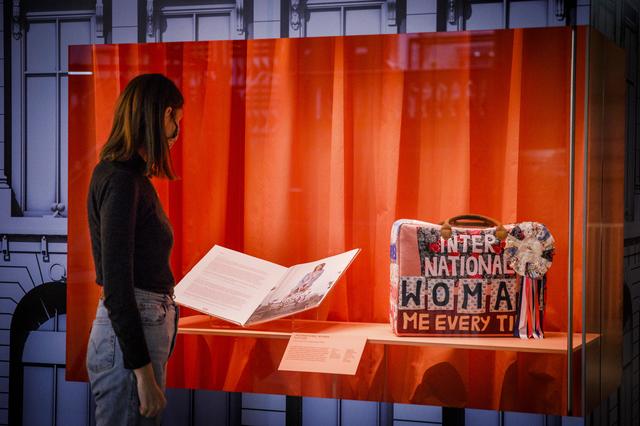Aesthetic and political theory of the bag
The Victoria & Albert Museum in London traces through 250 pieces the history of a accessory loaded with social and creative meaning in the exhibition 'Bags: Inside Out'
Rafa de MiguelLondon -The interior of a suitcase or a bag is a reflection of the way of thinking of its owner. Its external appearance, a symbol of social status, a declaration of intentions before the world and even a political manifesto. The Victoria & Albert Museum in London has finally presented the exhibition Bags: Inside Out (Bags: from inside out), after confinement delayed an opening scheduled for last April.
More informationPhoto gallery: History through bagsIt could have been called Handbags, the English term for the handbag that millions of women wear around the world. But it is called Bags (bags / handbags), "because although when you think of bags, you think of women, it is not true at all," defends the Italian Lucia Savi, curator of the exhibition. “Men, and also boys and girls, have used bags throughout history. We build our identity with the accessories we wear, and we already live in a time when men wear bags, without caring at all”.
A story associated with each object of desire. Like the Birkin, whose design arose from a chance meeting between actress Jane Birkin and the CEO of the Hermès house on a commercial Air France flight. She complained about the lack of compartments that most bags had, and the need for it ended up creating an icon of the 20th century pursued as a major conquest by many collectors. Because a bag can become an investment piece whose value increases over time. “You can't walk into a store and just buy a Birkin. You have to get it. Sometimes through the second-hand market or auctions. It's the difficulty of getting it that makes a lot of people want it even more,” explains Savi. The exhibition shows the original bag, with the initials of the actress, on loan from a private collector. Or the Kelly, another Hermès jewel, with the right size and shape to hide Grace Kelly's incipient pregnancy. Or the Jackie, by Gucci, popularized in the seventies by Jacqueline Kennedy. Or the Lady Dior, the French firm's tribute to Princess Diana of Wales. "Each of the exhibits shows the way its owner wanted to be seen by the rest of the world," defends Georgia Mulvaney-Thomerson, one of the research assistants of an exhibition that has taken two and a half years to be ready . "This is not a bag, it's a baguette" (it's not a bag, it's a baguette), said actress Sarah Jessica Parker in the Fendi ad commemorating the sequined "bag" stolen by a robber in an alley desert, in the series Sex in New York.
Meditation 101 (3/4): How to Prepare Yourself for Meditation Yoga, meditation, mindfulness http://b http://t.co/cb6YRfE1Fw
— FiloTer Thu Apr 24 10:13:14 +0000 2014
The exhibition, with 250 pieces, shows the different ways in which the political strength of women is manifested. Like the eternal bag of the former British Prime Minister, Margaret Thatcher, who came to constitute a new verb by itself: to handbag, or give orders to a man with authority and firmness. Or the designs made by the artist Tracey Emin for the tenth anniversary of Longchamp with the legend “International Women” and the second-hand bags redecorated with powerful messages by another artist, Michele Pred: “My body, my business”, in luminous letters .
All the culture that goes with you awaits you here.Subscribe
Luxury and status in which the container becomes more valuable than the content. Winston Churchill's red briefcase (Red Box), which carried important state documents. The travel trunk designed by Louis Vuitton in 1900 for Emilie Busbey Grigsby, with the legendary anagram of the brand already erased by the passage of time and a multitude of labels to show all the places where the American socialite based in London moved.
The Victoria & Albert proposal suggests an endless world that says a lot about people's need to always exhibit their mark. The military bag used by the population to carry gas masks during the two World Wars is decorated with drawings and colors that hide the terror it faces. The red backpack, as simple as any other backpack, but with the huge white letters of the Supreme signature, shows the need for part of a generation to cling as an identity to the brands that the market offers them at all times. The bag designed by Anya Hindmarch in 2007 for the Sainsbury supermarket chain, made from organic materials and displaying the legend “I'm not a plastic bag”, cost £5 at the time. Just over five euros. Today it is a collector's item, but above all, the clear antecedent of a citizen movement from which no one can escape.
The exhibition concludes with a detailed reproduction of the manufacturing process of any bag, from the initial sketches to the patterns, from handling the skins or fabrics to the final embroidery or drawings. A close look at how some of the most coveted dreams are created.
about the signature
Rafael de MiguelHe is the correspondent for EL PAÍS for the United Kingdom and Ireland. He was the first CNN + correspondent in the US, where he covered 9/11. He has directed the Informative Services of the SER, was Editor-in-Chief of Spain and Deputy Director of EL PAÍS. He has a degree in Law and a Master's in Journalism from the School of EL PAÍS / UNAM.
Rules








1612